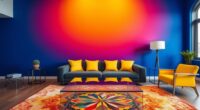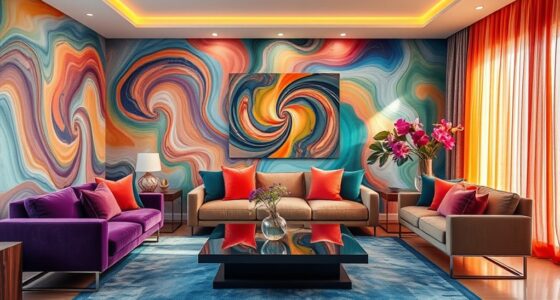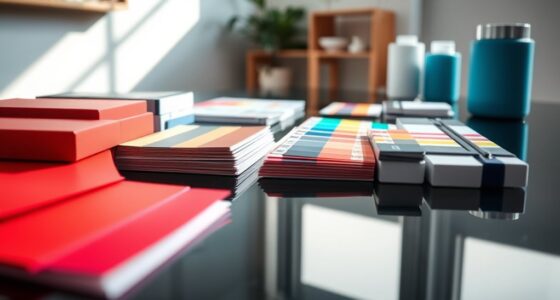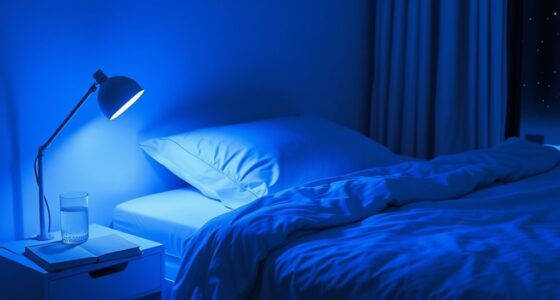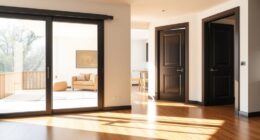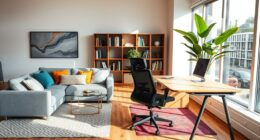The color of your walls can markedly impact your focus, motivation, and overall productivity. Studies show that blue creates a calm, focused environment ideal for deep work, especially shades like navy or lighter blues. Warm colors boost energy, but may distract, while cool blues reduce stress and improve concentration. If you want to optimize your space, choosing the right blue tones and incorporating natural light can make a big difference. Keep exploring to learn more about designing a productive workspace.
Key Takeaways
- Blue walls promote calmness and focus, boosting productivity and reducing stress in work environments.
- Incorporating shades of blue, especially darker tones, enhances concentration and supports strategic thinking.
- Avoid overly bright or clashing colors that can distract or hinder focus, limiting work efficiency.
- Personalize blue spaces with accessories and lighting to maximize their calming and productivity-enhancing effects.
- Proper wall finishes and natural lighting amplify the benefits of blue, creating an optimal workspace environment.
The Psychology Behind Color and Productivity

Colors can profoundly influence your mood and focus, which in turn affects your productivity. This is the core idea behind color therapy, which explores how different hues trigger specific emotional responses. When you’re in a workspace painted with certain colors, your brain reacts instinctively, either calming you down or energizing you. For example, warm colors like red and orange can boost enthusiasm and motivation, while cooler shades like green and blue promote relaxation and clarity. Understanding this emotional response helps you choose colors that optimize your work environment. Additionally, incorporating trendy dog sweaters can add a touch of personality and comfort to your space, making it more inviting. By intentionally selecting colors based on their psychological effects, you can create a space that enhances focus, reduces stress, and ultimately increases your productivity throughout the day.
Why Blue Is Known as the Ultimate Work Color
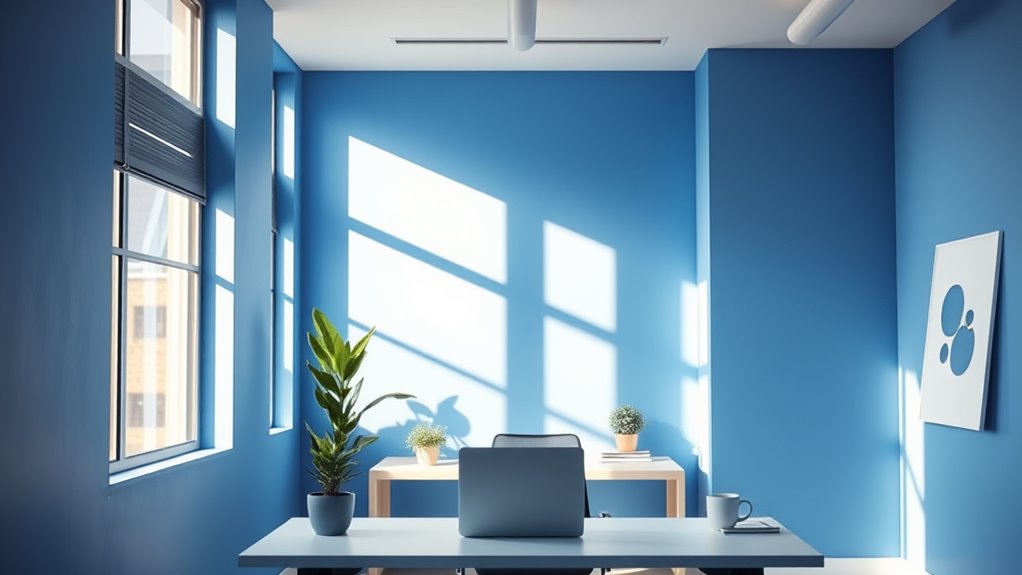
Among the various hues that influence your workspace, blue stands out as the most effective for boosting productivity. In color therapy, blue is known to promote calmness, focus, and mental clarity, making it ideal for work environments. Incorporating blue into your wall decor can create a tranquil atmosphere that reduces stress and enhances concentration. Studies show that blue helps slow heart rate and lower blood pressure, which fosters a sense of stability and confidence. When you choose blue for your walls, you’re not only making a stylish statement but also supporting your cognitive function. This color’s ability to promote a peaceful environment encourages sustained attention and efficiency, making it the ultimate work color for those seeking to optimize productivity.
How Different Shades of Blue Affect Your Focus

Different shades of blue can considerably influence your focus, with some creating a calming environment while others boost concentration. Lighter blues tend to be more relaxing, helping you stay steady, whereas darker shades can sharpen your focus for demanding tasks. By choosing the right blue environment, you can optimize your productivity and maintain better concentration throughout your workday. Incorporating dynamic communication exercises into your routine can also enhance your ability to stay engaged and focused during work sessions.
Calming and Focus Enhancer
Shades of blue are renowned for their calming effects, making them ideal for enhancing focus. In color therapy, blue is used to promote tranquility and reduce stress, helping you stay centered during demanding tasks. Different blue shades can also aid in mood regulation, creating an environment that minimizes anxiety and distractions. Light blues tend to evoke a sense of serenity, encouraging mental clarity, while deeper blues foster concentration and stability. By incorporating these shades into your workspace, you set a peaceful tone that supports sustained attention. This calming influence helps you stay productive without feeling overwhelmed. Choosing the right blue can transform your environment into a focused, stress-free zone, boosting your ability to work efficiently and maintain mental balance throughout your day. Regularly assessing and creating designated zones can optimize your space for better focus and organization.
Shades and Concentration Levels
While blue is generally known for its calming effects, the specific shade you choose can considerably influence your level of focus. In color therapy and wall color psychology, lighter blues promote relaxation, making them ideal for reducing stress, but may sometimes hinder alertness. On the other hand, darker shades like navy or slate encourage concentration and mental clarity, boosting productivity. The key is selecting a shade that balances calmness with alertness, depending on your work demands. Different shades of blue can either enhance or diminish your focus, so consider how each hue interacts with your environment. Additionally, understanding the psychological impact of color can help you select the perfect hue to optimize your workspace. By understanding how various shades impact your concentration levels, you can customize your space to achieve maximum productivity and stay attentive throughout your workday.
Optimal Blue Environments
Choosing the right shade of blue for your workspace can substantially enhance your focus and productivity. Different shades evoke unique responses in color psychology, influencing your mood and work efficiency. Light blue promotes calmness and clarity, perfect for detailed tasks, while darker blues foster stability and trust, ideal for strategic thinking. When selecting blue for your workspace aesthetics, consider how it aligns with your goals. Incorporating self watering plant pots can also create a soothing environment that boosts concentration and overall well-being.
Incorporating Blue Into Your Workspace Design

Incorporating blue into your workspace design can considerably boost your productivity by creating a calming and focused environment. Color therapy highlights blue’s ability to reduce stress and enhance concentration, making it ideal for work settings. To optimize workspace aesthetics, consider painting accent walls or incorporating blue desk accessories, such as organizers or artwork. Use shades like navy or sky blue to promote tranquility without overwhelming the senses. Natural light can amplify blue’s calming effects, so position your workspace near windows if possible. Keep balance in mind: too much blue might feel cold or distant, so add warm tones or greenery to create harmony. Additionally, integrating glycolic acid products into your skincare routine can improve skin clarity and radiance, helping you feel more confident and focused throughout your workday. By thoughtfully integrating blue, you foster an environment that encourages clarity, focus, and effective work habits.
Alternatives to Blue for Boosting Motivation and Creativity
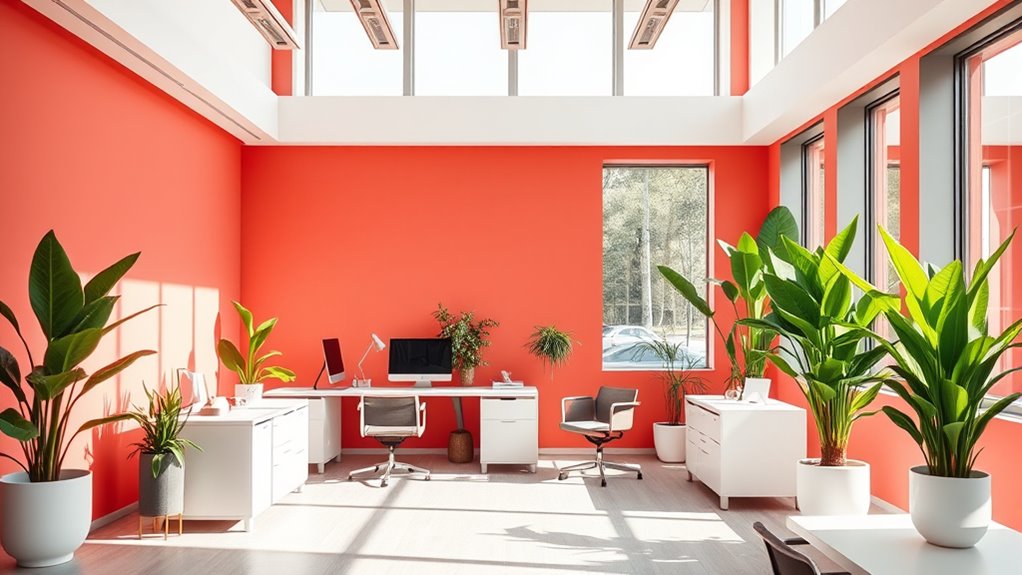
Although blue promotes calmness and focus, it might not be the best choice when you need a burst of motivation or spark of creativity. In this case, consider colors like orange or yellow, which are often used in color therapy to energize and inspire. Orange stimulates enthusiasm and social interaction, boosting your drive to generate new ideas. Yellow, associated with optimism and clarity, can enhance visual perception, helping you see solutions more clearly. These colors can create a lively environment that encourages innovative thinking. Using vibrant shades strategically in your workspace can stimulate your mind without overwhelming your senses. Additionally, incorporating color psychology principles can help you choose the most effective hues for productivity. Remember, the right color choice varies based on individual preference, but incorporating warm, energetic hues is generally effective for boosting motivation and creativity.
Tips for Painting Your Walls to Maximize Efficiency

To maximize efficiency when painting your walls, start by preparing the space thoroughly. Clear the area and cover furniture to avoid messes. Choose a wall texture that complements your workspace; smooth finishes typically apply faster and are easier to maintain, while textured walls can add visual interest but may take longer to paint evenly. Select high-quality paint with good durability to ensure your walls withstand daily wear and cleaning, reducing touch-ups later. Use painter’s tape for clean edges and invest in good brushes and rollers to speed up the process. Plan your painting in sections, starting from the corners and working inward. Proper prep and quality materials help you finish faster and create a professional, long-lasting finish that supports your productivity. Additionally, understanding paint application techniques can further improve your efficiency and the overall quality of your work.
Common Mistakes to Avoid When Choosing Office Colors
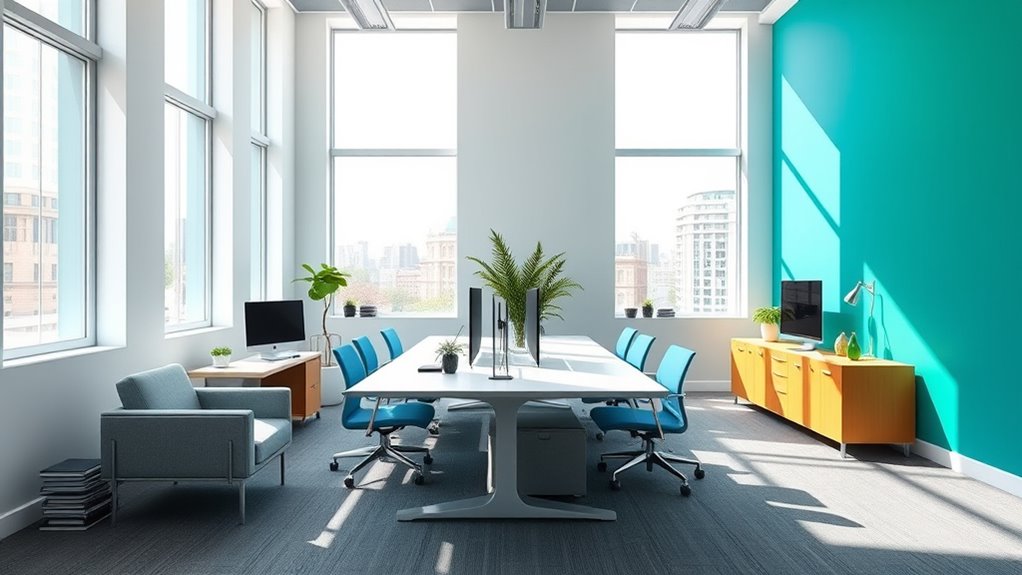
Choosing the right office colors is essential for creating a productive environment, but many people make avoidable mistakes that can undermine their efforts. One common error is choosing colors that clash, creating visual tension instead of harmony. Avoid selecting bold or overly bright shades that can cause distraction or fatigue. Additionally, don’t overlook wall accessories, which can clash with your chosen color scheme; mismatched frames or artwork can disrupt the room’s balance. Always consider how accessories complement your walls rather than compete with them. Another mistake is sticking to a single color without variation or contrast, which can make the space feel dull. Use subtle variations and accents to add depth and interest, ensuring your office remains inviting and conducive to productivity. Incorporating appropriate lighting can also enhance your color choices and improve overall workspace ambiance.
Personalizing Your Space to Enhance Productivity
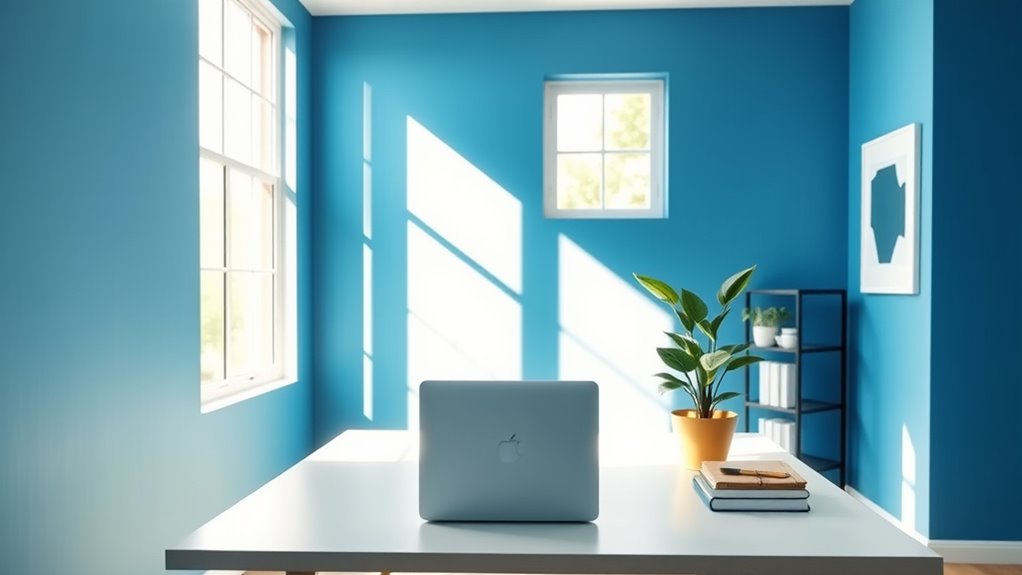
Personalizing your workspace can considerably boost your productivity by making it feel more comfortable and inspiring. When you tailor your personal space, you create an environment that reflects your style and motivates you to focus. Incorporate wall textures, such as cork boards, murals, or textured paint, to add visual interest and make the space uniquely yours. These textures can serve as creative outlets or organizational tools, helping you stay productive. Adding personal touches like artwork, photos, or meaningful objects also fosters a sense of ownership and comfort. The key is balancing personalization with simplicity so your environment remains uncluttered and conducive to concentration. Additionally, considering environmental factors like wall color and temperature can further enhance your workspace’s productivity. By customizing your space thoughtfully, you make it easier to stay engaged and energized throughout your workday.
Frequently Asked Questions
Can Wall Colors Impact Employee Mood and Team Dynamics?
Wall colors definitely impact employee mood and team dynamics. Through color psychology, you can create a workplace environment that boosts positivity and collaboration. Bright, calming colors like blue or green promote focus and reduce stress, while energetic hues like yellow can inspire creativity. By choosing the right colors, you influence how your team interacts and feels, making your workspace more productive and harmonious.
How Long Does It Take to See Productivity Improvements After Repainting?
Once you paint, patience is key—think of it as the calm before the storm. Usually, you’ll see productivity improvements within a week or two, depending on how quickly the paint dries and the color change duration. Fresh paint can boost morale and focus fast, but give it a few days to settle in fully. After that, you’ll notice a more energized, motivated workspace ready to hit the ground running.
Are There Any Colors That Hinder Productivity or Creativity?
Certain colors can hinder your productivity and creativity by affecting your mood through color psychology. Dark shades like deep reds or browns may feel overwhelming or dull, reducing motivation. Bright, overly stimulating colors can cause distraction rather than focus. When designing your workspace aesthetics, avoid these hues if you want to stay energized and creative. Choosing calming, balanced colors helps foster a productive environment, so select carefully to optimize your workspace’s impact.
How Do Lighting Conditions Influence the Effectiveness of Wall Colors?
Lighting can make or break your wall color choices. You might think your walls are perfect, but poor lighting contrast or excessive wall reflection can wash out colors or create glare, reducing focus. Bright, natural light enhances warm tones and minimizes reflection, while dim or harsh lighting can dull colors and cause eye strain. Adjust your lighting to complement your wall colors, ensuring your environment stays productive and comfortable.
Is It Beneficial to Combine Multiple Colors in a Workspace?
Mixing multiple colors in your workspace can boost creativity and energy if you achieve proper color coordination. Use complementary shades to create visual interest without overwhelming your senses. Opt for a matte or eggshell paint finish to reduce glare and maintain a calm environment. Be mindful of how different colors interact, balancing bold with neutral tones, so your workspace feels inspiring without causing distraction or fatigue.
Conclusion
Think of your workspace as a garden; the colors you choose are like seeds. Plant blue, and watch your focus bloom like a well-tended flower. Avoid dull or chaotic hues that can weeds your productivity. When you pick the right shades, you’re nurturing a space where ideas grow and work flourishes. So, choose your colors wisely—your environment can become the fertile ground for your best work.

